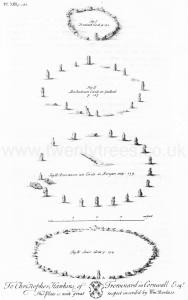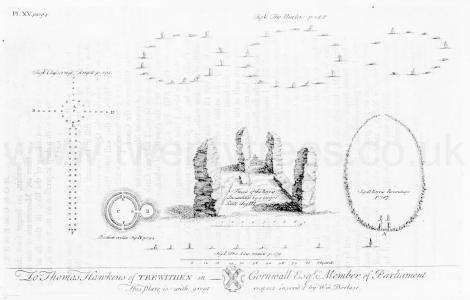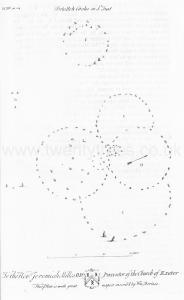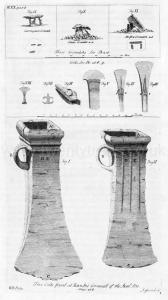The Antiquities of Cornwall by William Borlase
The Antiquities of Cornwall by William Borlase is in Georgian Books.
Observations On The Antiquities Historical And Monumental , Of The County Of Cornwall Consisting Of Several Essays On The First Inhabitants, Druid-Superstition, Customs, And Remains Of The Most Remote Antiquity, In Britain, And The British Isles: Exemplify'd And Prov'd By Monuments Now Extant In Cornwall And The Scilly Islands, Faithfully Drawn On The Spot, And Engrav'd According To Their Scales Annex'd. With A Summary Of The Religious, Civil, And Military State Of Cornwall Before The Norman Conquest; Illustrated By The Plans And Elevations Of Fcveral Ancient Caftles, An Eastern View Of The Monastery And Site Of St. Michael'S Mount: And A Vocabulary Of The Cornu-British Language. By William Borlase, A. M. F.R.S. Rector Of Ludgvan. Miratur , Facilesque Oculos Fert Omnia Circum. Ænas Capiturque Locis , Et Singula Lætus Exquiritque, Auditque Virûm Monumenta Priorum. Virg. Mdccliv.
Georgian Books, The Antiquities of Cornwall by William Borlase Chapter VII
Of Circular Monuments, the Use and Design of them among, the Ancients in foreign Countries, and the Druids in this.
Of these Monuments that kind was most ancient which was most simple, and consisted only of a Circle of Stones-erect. Of this fort we have a great number in Cornwall, which differ not materially from one another, Boskednan Circle [Map] therefore (Plat. XIII. Fig. ii.) may represent the whole.

Of this kind is the Monument call'd the Hurlers [Map], in the Parish St. Clere, Cornwall, the Stones of which, by the vulgar, are suppos'd to have been once Men, and thus transform'd, as a punishment for their hurling upon the Lord's Day.1 This Monument consisted of three Circles from which many Stones are now carry'd off; what remain, and their distances may be seen (Plate XV. fig. vi.).
Note 1. Hurling, is playing with a Ball, and endeavouring to get at the Goal with it before one's Antagonist; an antient tryal of Strength and Swiftness among the Cornish.

Again, some of these Circles include, and intersect one the other, as in the curious cluster of Circles at Botallek [Map], (Plate XIV.) in the seeming consusion of which I can't but think that there was some mystical meaning, or, at least, distinct allotment to particular uses. Some of these might be employ'd for the Sacrifice, and to prepare, kill, examine, and burn the Victim, others allotted to Prayer, others to the Feasting of the Priests, others for the station of those who devoted the Victims: Whilst one Druid was preparing the Victim in one Place, another was adoring in another, and describing the limits of his Temple; a Third was going his round at the extremity of another Circle of Stones; and, likely, many Druids were to follow one the other in these mysterious Rounds: Others were busy in the Rights of Augury, that so all the Rites, each in it's proper place, might proceed at one and the same time, and under the inspection of the High-Priests; who, by comparing and observing the indications of the whole, might judge of the Will of the Gods with the greater certainty: Lastly, that these Circles intersected each other in so remarkable a manner as we find them in this Monument, might be, to intimate that each of these Holy Rites, though exercised in different Circles, and their own proper compartments, were but so many Rings, or Links, of one and the same chain, and that there was a constant dependance, and connexion betwixt Sacrifice, Prayer, Holy Feasting, and all the several parts of their Worship.

Georgian Books, The Antiquities of Cornwall by William Borlase Chapter IX
Of the Cromlêh.
In several parts of Cornwall we find a large flat Stone in a horizontal position (or near it) supportcd by other flat Stones fix'd on their edges, and fasten'd in the ground, on purpose to bear the weight of that Stone, which rests upon, and over-shadows them, and by reason of it's extended surface, and it's elevation of fix or eight feet, or more, from the ground makes the principal figure in tliis kind of Monument. The situation which is generally chosen for this Monument is the very summit of the hill, and nothing can be more exact than the placing some of them, which shews, that those who erected them were very sollicitous to place 'em as conspicuously as possible. Sometimes this flat Stone, and it's supporters, stand upon the plain natural soil, and common level of the ground; but at other times it is mounted on a Barrow made either of Stone or Earth; it is sometimes plac'd in the middle of a Circle of Stones-erect, and when it has a place of that dignity, must be suppos'd to be erected on some extraordinary occasion; but when a Circle has a tall Stone in the middle, it seems to have been unlawful to remove that middle Stone, and therefore we find this Monument of which we are speaking sometimes plac'd on the edge of a Circlec. But we find fome Cromlêhs erected on such rocky situations, and so distant from houses, (where no Stones-erect do stand, or appear to have flood,) that we may conclude, they were often erected in places where there were no such Circles. Some of these Monuments are quite inclos'd, and buried, as it were, in the Barrow; As that of Senor in Cornwall (Plate XVIII. Fig. iii.) and that at Chûn [Map] (Plate XX. Fig. x.) and that mention'd by Wormius, pag. 4. Mon. Dan.d
Note c. Sec Pl. XIII. Fig. iii. a, and b, in Boscawen-ûn [Map] from which we may draw this Consequence; that the Cromlêhs was posteriour in date to the Circle, and the former erected there for the sake of the latter.
Note d. One only which I have yet heard of, has it's Supporters, or Side-Stones, fix'd on a solid Rock. State of Downe, pag. 199.

